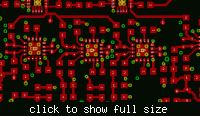Zangetsu57
Member level 4
Hello everyone,
What I'm doing is developing a circuit that can take two square wave inputs (LVTTL) that are offset by a very short period of time (offset on the order of several hundred picoseconds to several nanoseconds), then output which signal reaches a specified DC threshold voltage first. The thought is to use the LT1720 dual comparator to compare the two signals to a DC voltage (150mV in this case), then feed the output to an OR gate.
The problem I'm having is the OR gate output overshoots and oscillates quite a bit before settling. I removed the OR gate from the circuit, and noticed that the output of the LT1720 comparators also overshoots quite a bit, oscillates, then finally settles. It does this when the state changes from low to high and high to low. The current rise time is about 2.5 ns. I'm thinking that if I simply reduce the rise time by increasing the RC time constant for the output, this will fix itself. I'm not entirely certain how to accomplish this, however, since adding a more resistive load doesn' t seem to affect the rise time.
Here is what I've done to try and remedy the issue:
1. Ensure good supply bypassing. Not the problem. I'm using a 10nF ceramic, 2.2 uF tantalum, and 10uF tantalum capacitor within 1 cm of the IC.
2. Check the input signal for overshoot. It is a very clean signal with about 20ns rise time, so that isn't the problem.
3. Check for good grounding. I don' t think this is the issue either, and I've tested jumper wires to see if this affects the output.
The only thing I can think of is the outputs are close together, and perhaps there is some capacitive coupling going on.
I'd be indebted for any assistance. I've tried to fix the problem, but am out of ideas, and graduation is near and I need to get this thing working.
Thank you!
EDIT: I've uploaded pictures of the overshoot off the scope. Note that I'm using an old 100 MHz tektronics scope, but I've double checked that the problem isn't limited by the bandwidth of the scope by using a 50 ohm 16 GHz digitizing phosphor tektronics scope (which just isn't ideal since it is for RF devices and has low input impedance).
EDIT 2: Uploaded Layout of bottom. Red x's indicate vias.
What I'm doing is developing a circuit that can take two square wave inputs (LVTTL) that are offset by a very short period of time (offset on the order of several hundred picoseconds to several nanoseconds), then output which signal reaches a specified DC threshold voltage first. The thought is to use the LT1720 dual comparator to compare the two signals to a DC voltage (150mV in this case), then feed the output to an OR gate.
The problem I'm having is the OR gate output overshoots and oscillates quite a bit before settling. I removed the OR gate from the circuit, and noticed that the output of the LT1720 comparators also overshoots quite a bit, oscillates, then finally settles. It does this when the state changes from low to high and high to low. The current rise time is about 2.5 ns. I'm thinking that if I simply reduce the rise time by increasing the RC time constant for the output, this will fix itself. I'm not entirely certain how to accomplish this, however, since adding a more resistive load doesn' t seem to affect the rise time.
Here is what I've done to try and remedy the issue:
1. Ensure good supply bypassing. Not the problem. I'm using a 10nF ceramic, 2.2 uF tantalum, and 10uF tantalum capacitor within 1 cm of the IC.
2. Check the input signal for overshoot. It is a very clean signal with about 20ns rise time, so that isn't the problem.
3. Check for good grounding. I don' t think this is the issue either, and I've tested jumper wires to see if this affects the output.
The only thing I can think of is the outputs are close together, and perhaps there is some capacitive coupling going on.
I'd be indebted for any assistance. I've tried to fix the problem, but am out of ideas, and graduation is near and I need to get this thing working.
Thank you!
EDIT: I've uploaded pictures of the overshoot off the scope. Note that I'm using an old 100 MHz tektronics scope, but I've double checked that the problem isn't limited by the bandwidth of the scope by using a 50 ohm 16 GHz digitizing phosphor tektronics scope (which just isn't ideal since it is for RF devices and has low input impedance).
EDIT 2: Uploaded Layout of bottom. Red x's indicate vias.
